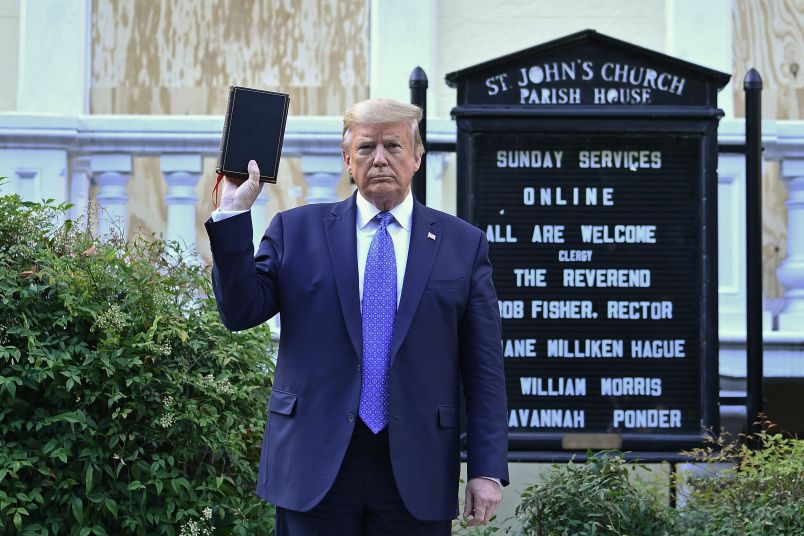The Park Police used tear gas and “excessive use of force” in June to clear protestors to make way for President Trump’s infamous Lafayette Park photo op, according to congressional testimony from a whistleblowing officer from the D.C. National Guard.
The account, by D.C. National Guard Maj. Adam DeMarco in testimony for the House Natural Resources Committee, offers firsthand details about the federal operation to push nonviolent Black Lives Matter protestors out of Lafayette Square, clearing the way for President Trump’s photo op at a historic church on the plaza.
DeMarco’s testimony publicly contradicts the statements of Attorney General Bill Barr, who was also present at the clearing, and later said that he and other officials did not order the square violently cleared to make room for the President and his entourage. In a June 4 press conference, Barr took responsibility for “moving the perimeter,” but denied that there was a “correlation” with President Trump’s photo op.
The Park Police have defended the operation by claiming that it was necessary in order to build a fence that would provide more security for the White House.
But DeMarco wrote that fencing materials did not arrive until nearly three hours after federal law enforcement gassed and cleared the crowd.
Since the June 1 clearing of Lafayette Square, the Trump Administration has surged federal law enforcement into Portland, Oregon, tear gassing the city’s mayor as the President threatens to deploy federal troops around the country.
DeMarco told lawmakers in the written testimony that he was deployed as a National Guard liaison with the U.S. Park Police on June 1.
“Having served in a combat zone, and understanding how to assess threat environments, at no time did I feel threatened by the protestors or assess them to be violent,” DeMarco wrote. “In addition, considering the principles of proportionality of force and the fundamental strategy of graduated responses specific to civil disturbance operations, it was my observation that the use of force against demonstrators in the clearing operation was an unnecessary escalation of the use of force.”
An Iraq War veteran, DeMarco will testify before Congress on Tuesday.
While on the square, DeMarco wrote, he spoke with Chairman of the Joint Chiefs of Staff General Mark Milley.
Milley’s presence during the clearing broke with a foundational precedent separating the U.S. military from domestic affairs. Milley later apologized for appearing on the square, saying in a statement that his “presence in that moment, and in that environment, created the perception of the military involved in domestic politics.”
DeMarco offers what appears to be the first detailed account of Milley’s actions on the square, writing that the general spent around twenty minutes observing the security perimeter that the Park Police had established.
DeMarco wrote that Milley told him “to ensure that National Guard personnel remained calm, adding that we were there to respect the demonstrators’ First Amendment rights.”
Soon after, DeMarco wrote, Milley left, along with Attorney General Barr.
Immediately, the Park Police began to warn the protestors to disperse, though DeMarco cast doubt on whether the warnings were loud enough to have made it to the crowd of protestors.
Ten minutes after Milley and Barr departed the square, DeMarco began to watch as federal law enforcement began to clear the square.
“As the clearing operation began, I heard explosions and saw smoke being
used to disperse the protestors,” DeMarco wrote.
A Park Police officer told DeMarco that “stage smoke” was being used to disperse the crowds, but, the national guardsman wrote, “I could feel irritation in my eyes and nose, and based on my previous exposure to tear gas in my training at West Point and later in my Army training, I recognized that irritation as effects consistent with CS or ‘tear gas.’
“And later that evening, I found spent tear gas canisters on the street nearby,” he added.
At the end of the clearing operation, DeMarco ended up at a position near St. John’s Church — where, unbeknownst to the guardsman, President Trump would arrive for the photo shoot.
“At around 7:05 pm, I saw the President walking onto H Street from Lafayette Square, near St. John’s Church, accompanied by his security detail,” DeMarco wrote. “The President’s arrival was a complete surprise, as we had not been briefed that he would enter our sector.”
Read Maj. DeMarco’s testimony here:







This hearing is going to be lit.
Surprised Barr hasn’t ordered him to stand down from testifying yet… Maybe this one snuck in under their radar, and they’ll arrest him first thing in the morning.
Lock 'em up. All of them. Trump, Barr, DHS, CBP, and Erik Prince.
And the character assassination begins in 3…2…1…
It’ll be a gas.